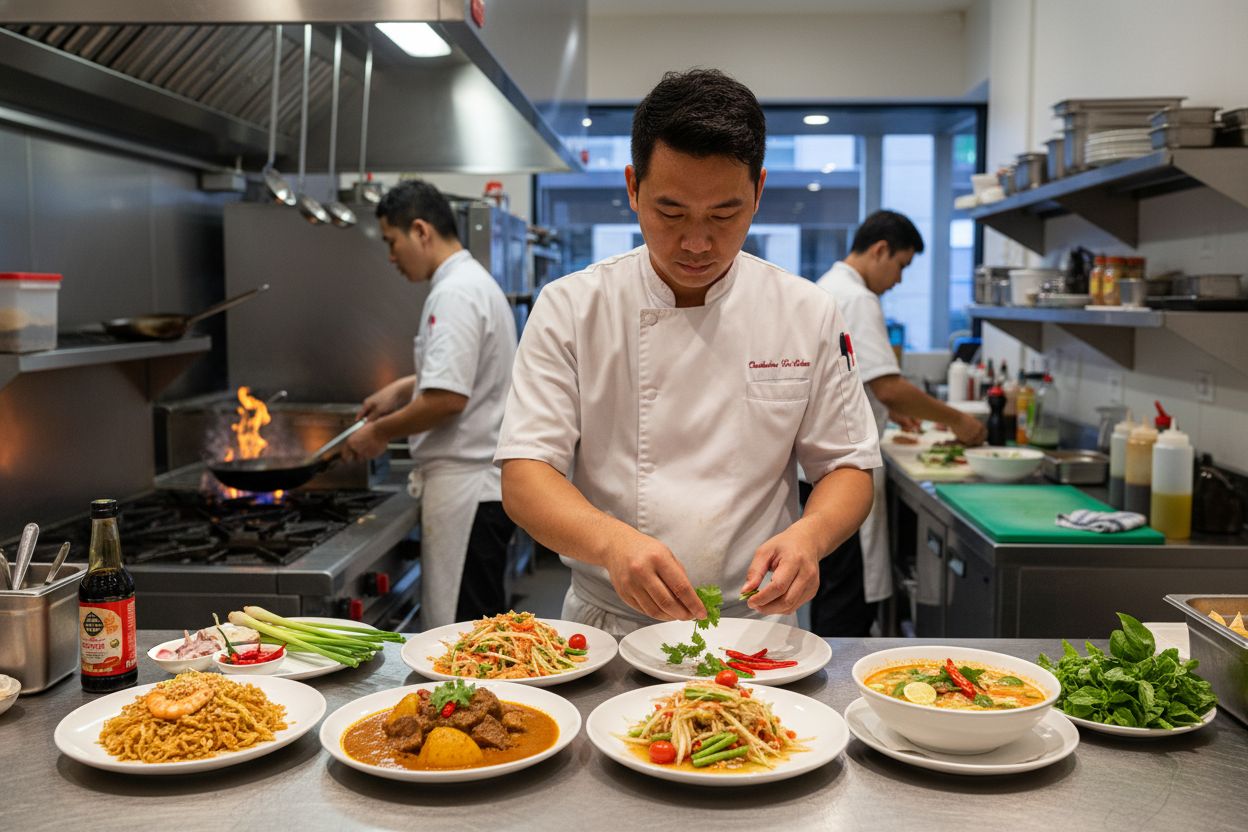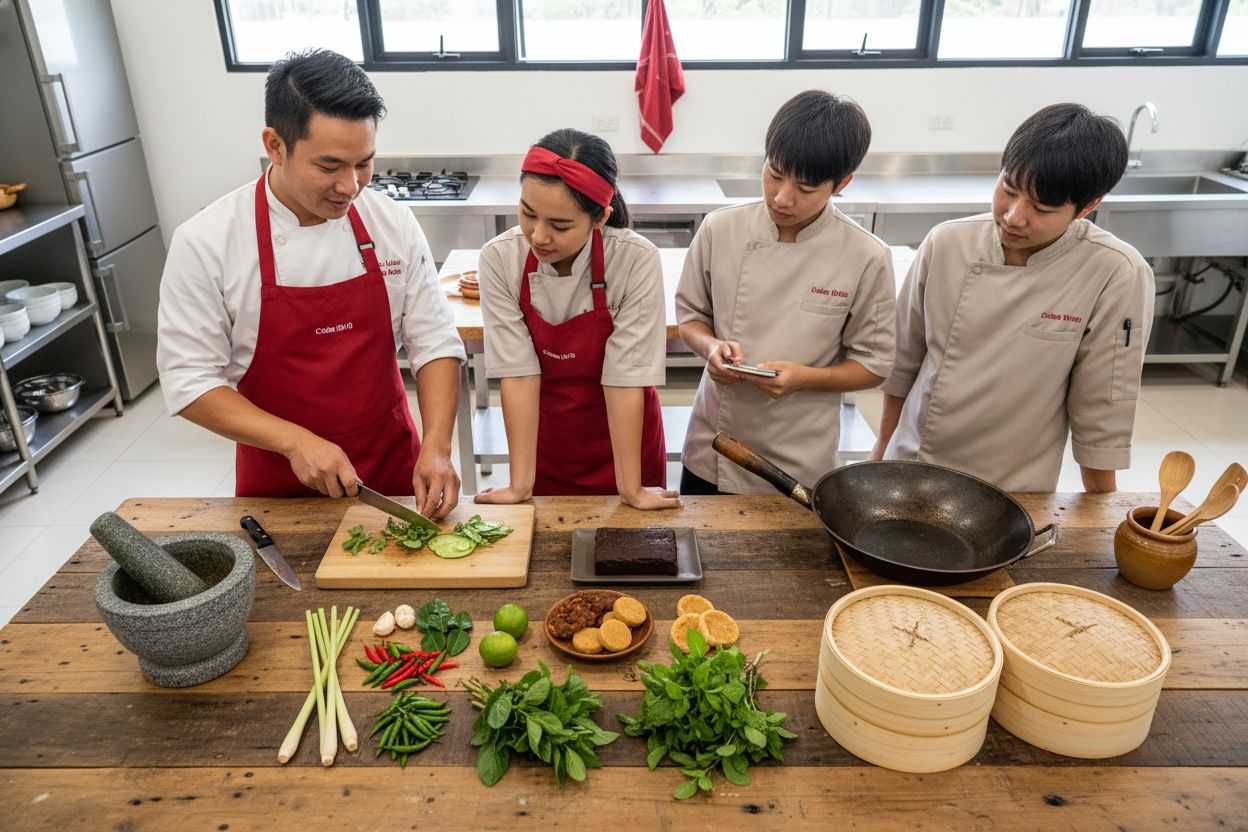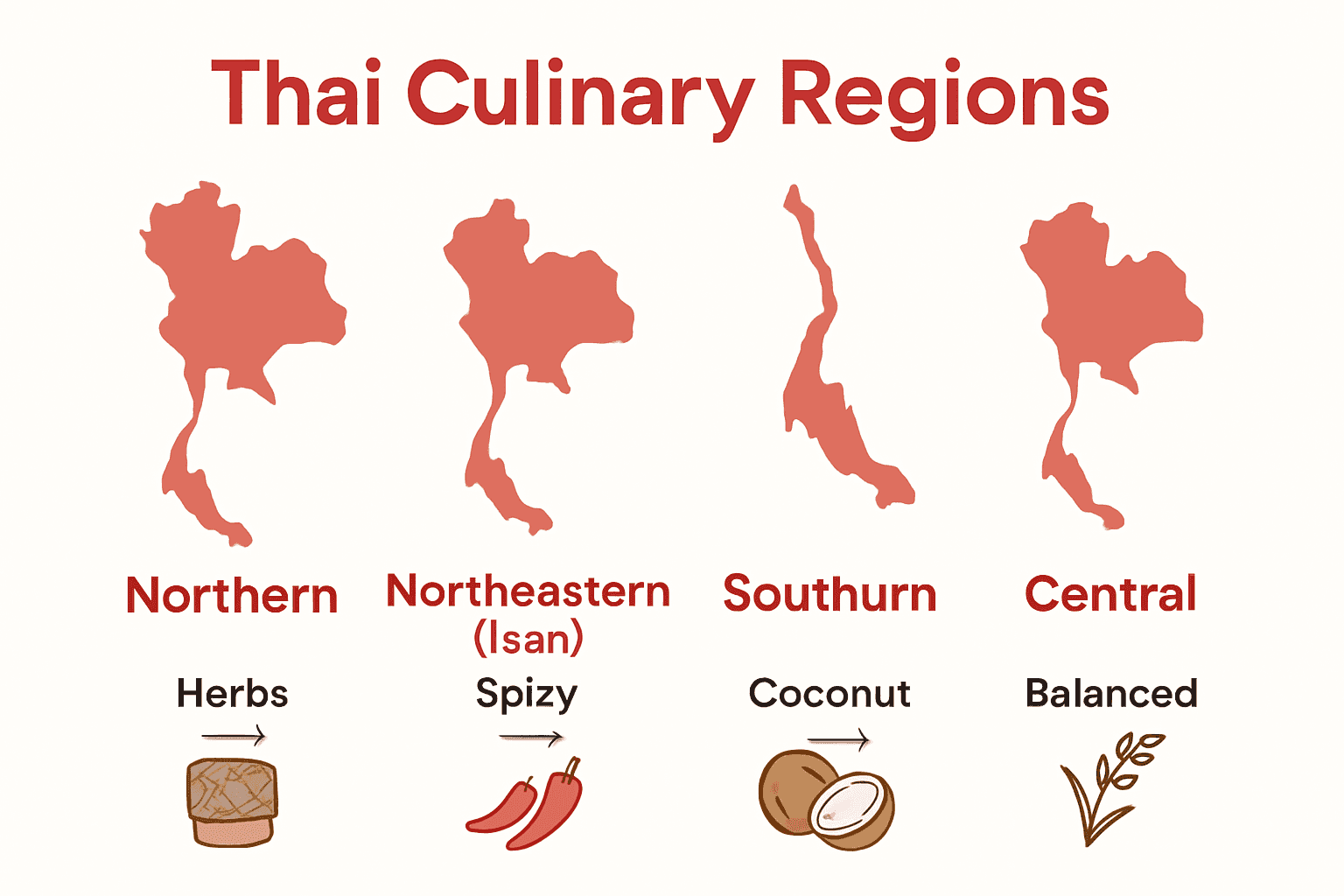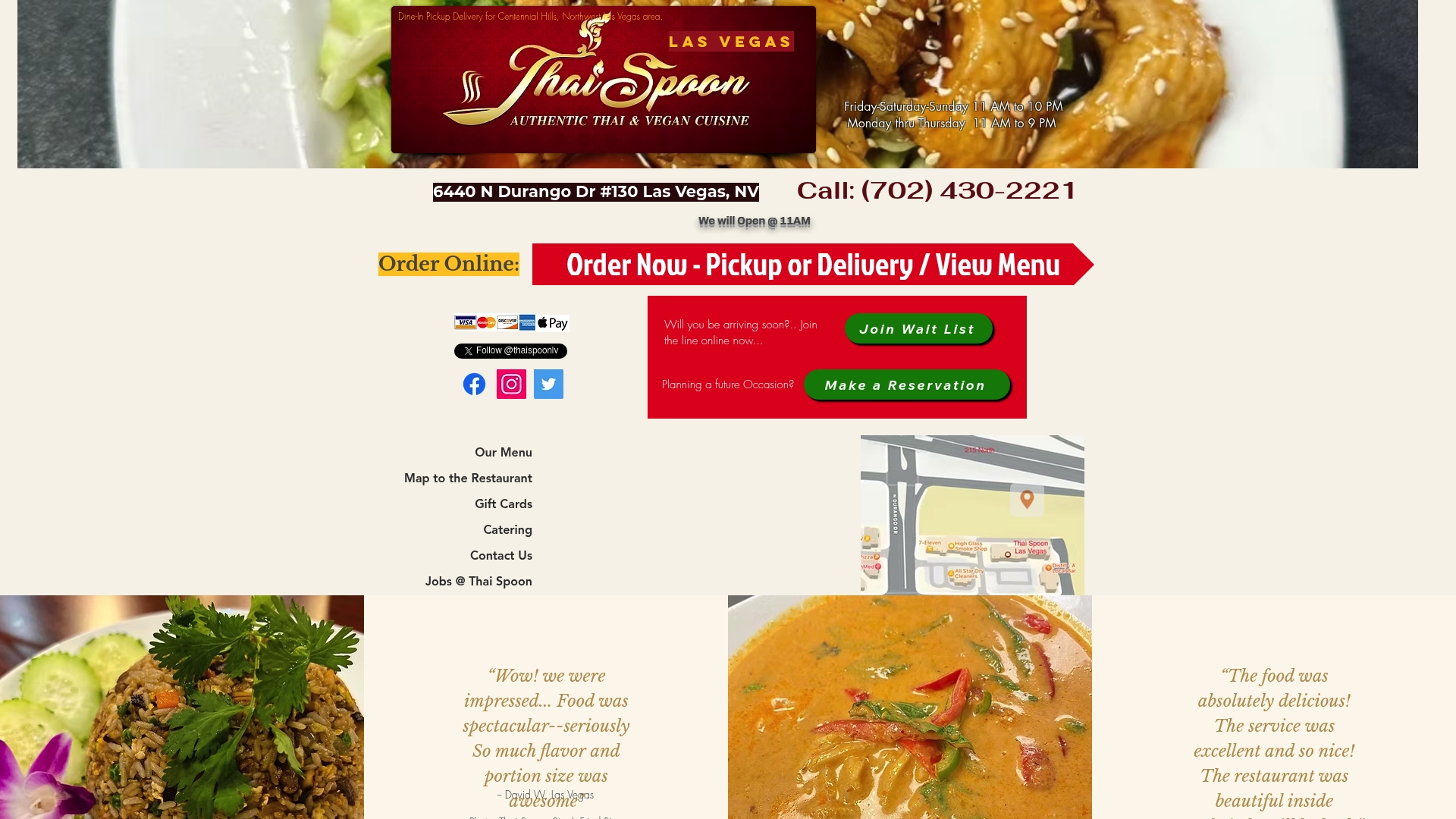Complete Guide to What Makes Thai Cuisine Unique
- mail469793
- Oct 14
- 8 min read

More than 30,000 Thai restaurants exist worldwide, showing just how beloved Thai cuisine has become across the globe. This popularity springs from a rich culinary tradition where centuries of trade, migration, and creative exchange have shaped every spicy, sweet, and aromatic bite. Experiencing Thai food means discovering vibrant flavors, unique regional dishes, and ingenious cooking methods that combine culture, history, and unforgettable taste in every meal.
Key Takeaways
Table of Contents
Thai cuisine is a vibrant culinary tradition that reflects centuries of cultural interactions, geographical influences, and complex flavor profiles. According to research from Wikipedia, the cuisine has developed through intricate exchanges with neighboring Southeast Asian cultures including Cambodia, Laos, Myanmar, India, Malaysia, and Indonesia, while also absorbing significant Chinese and Western cooking influences.
The historical journey of Thai food is remarkable. Spice trading and cultural migrations brought profound transformations to traditional cooking methods. For instance, Indian culinary practices introduced sophisticated spice techniques, while Chinese trade interactions contributed unique cooking styles. A fascinating turning point came during the Columbian Exchange, when chili peppers from the Americas dramatically reshaped Thai flavor profiles, introducing the intense heat now synonymous with Thai dishes.
Documenting this rich culinary heritage, the 1908 Siamese cookbook ‘Mae Khrua Hua Pa’ stands as a critical historical record. As historical sources indicate, this cookbook represents the first comprehensive written collection of Siamese recipes, preserving classic dishes like Massaman curry and providing invaluable insights into the evolution of Thai gastronomy.
Key characteristics that define Thai cuisine include:
Complex flavor balance between sweet, sour, salty, and spicy
Extensive use of fresh herbs and aromatics
Emphasis on fresh ingredients and minimal processing
Regional diversity reflecting local agricultural traditions
Understanding Thai cuisine means appreciating a dynamic culinary landscape that continues to evolve while maintaining deep cultural roots. Read more about the nuanced world of Thai cuisine culture and discover the rich tapestry of flavors that make this cuisine truly extraordinary.
Thai flavor profiles represent a symphony of tastes that dance across the palate with extraordinary complexity. According to research from Wikipedia, Thai cooking prominently features an intricate blend of fresh herbs, spices, and ingredients that create its distinctive culinary signature.
Flavor Foundations
At the heart of Thai cuisine are several foundational ingredients that build depth and character. Fish sauce delivers profound umami, while palm sugar introduces a nuanced sweetness different from standard granulated sugar. Discover more about these signature spices that transform ordinary dishes into extraordinary culinary experiences.
Key Ingredients
The most critical ingredients in Thai cooking include:
Fresh Herbs: Lemongrass, coriander, kaffir lime leaves
Aromatics: Garlic, galangal, shrimp paste
Heat Sources: Bird’s eye chilies, large red chilies
Souring Agents: Tamarind paste
Protein Variations: Pork, chicken, duck, and regional proteins like water buffalo and goat
What makes Thai cuisine truly remarkable is its ability to balance these ingredients.

Tamarind paste provides layered sourness, while various chilies contribute not just heat but also color and depth. The result is a cuisine that stimulates every taste receptor simultaneously, creating an unforgettable sensory experience that goes far beyond simple sustenance. Learn more about the intricate Thai taste profile and unlock the secrets of this extraordinary culinary tradition.
Thai cooking techniques represent a sophisticated culinary art that transforms simple ingredients into extraordinary dishes. According to research from Asian Inspirations, Thai cuisine employs a diverse range of cooking methods that are carefully selected to enhance each ingredient’s unique characteristics.
Core Cooking Techniques
Traditional Thai cooking encompasses several fundamental techniques that bring out remarkable flavors:
Stir-Frying: Rapid high-heat cooking that preserves ingredient texture and nutrition
Steaming: Gentle method perfect for delicate proteins and preserving nutritional integrity
Grilling: Imparts smoky flavors and creates beautiful caramelization
Deep-Frying: Creates crispy exteriors while maintaining moisture
Stewing: Develops complex flavor profiles in curries and soups
Essential Cooking Tools
Explore the essential tools of Thai cuisine, which are as critical to the cooking process as the techniques themselves. Carbon steel woks create the distinctive ‘wok hei’ flavor through intense heat distribution, while granite mortars and pestles are crucial for grinding fresh curry pastes that form the foundation of many dishes. Bamboo steamers (huad) play a particularly important role in achieving perfect texture for sticky rice and steamed specialties.
What sets Thai cooking apart is the intentionality behind each technique.
Chefs don’t just cook—they carefully select methods that maximize flavor, preserve nutritional value, and create a sensory experience that goes far beyond mere sustenance. The result is a cuisine that is simultaneously precise and wildly creative, transforming humble ingredients into culinary masterpieces that tantalize every sense.
Thai regional cuisines represent a stunning culinary mosaic, where geography, cultural influences, and local ingredients create distinctly unique flavor landscapes. Research from Wikipedia reveals an extraordinary diversity that transforms Thai food from a singular concept into a rich, multifaceted gastronomic experience.
Regional Flavor Profiles
Here’s a comparison of the key regional characteristics of Thai cuisine:
Each Thai region tells a unique culinary story:

Northern Thailand: Shares cooking traditions with Shan, Laos, and Yunnan
Northeastern (Isan): Displays similarities to Vietnamese flavor profiles
Southern Thailand: Incorporates coconut milk and turmeric, reminiscent of Malaysian and Indian cuisines
Central Thailand: Reflects royal and urban cooking traditions
Cultural Culinary Influences
The regional variations aren’t just about ingredients—they’re about deep cultural exchanges. Northern dishes often feature lighter, less spicy preparations, while Southern cuisine bursts with intense flavors and abundant seafood. Learn more about authentic Thai regional cooking techniques, which demonstrate how local environments dramatically shape cooking styles.
Royal Culinary Heritage
Most fascinating is the royal cuisine from the Ayutthaya period, which has profoundly shaped Thailand’s broader culinary culture. This refined cooking tradition emphasizes intricate presentation, sophisticated techniques, and a remarkable variety of ingredients. The royal courts didn’t just cook—they created culinary art that transformed simple ingredients into extraordinary experiences, setting standards that continue to influence Thai cooking today.
Modern Thai cuisine is experiencing a remarkable transformation, adapting to contemporary dietary needs while preserving its rich culinary heritage. According to research from Alice Recipes, Thai food is now embracing plant-based innovations and health-conscious modifications that make traditional dishes more accessible to diverse dietary preferences.
Dietary Adaptations
The most significant shifts in Thai cuisine include:
Vegetarian and Vegan Options: Reimagining classics like Green Curry and Pad Thai
Health-Conscious Modifications: Reducing sodium and sugar content
Organic Produce Integration: Emphasizing farm-to-table ingredients
Flexible Dietary Accommodations: Creating gluten-free and plant-based alternatives
Traditional Wellness Foundations
Explore how traditional Thai eating patterns support modern health goals, which naturally align with global nutritional recommendations. Traditional meal structures inherently feature plant-centric dishes, fresh herbs, and cooking methods like steaming and grilling that preserve nutritional integrity. These ancient practices are now being recognized as fundamentally aligned with contemporary wellness trends.
The beauty of Thai cuisine’s adaptation lies in its ability to remain authentic while becoming incredibly versatile. Chefs and home cooks are reimagining traditional recipes to meet modern dietary needs—creating versions that are not just delicious, but also nutritionally balanced and inclusive. The result is a culinary tradition that continues to evolve, proving that truly great food can always find new ways to nourish and delight.
Thai cuisine myths have long prevented many food enthusiasts from exploring this incredible culinary tradition. According to research from Thai SQ, several persistent misconceptions have created unnecessary barriers to understanding and appreciating authentic Thai cooking.
Debunking Spice and Complexity Myths
Common misconceptions about Thai cuisine include:
Spice Intensity: Not every dish is extremely hot
Cooking Complexity: Many recipes are surprisingly simple
Ingredient Accessibility: Most ingredients are readily available
Cooking Methods: Beyond deep-frying, Thai cuisine uses diverse techniques
Ingredient and Preparation Realities
Discover the truth about Thai cooking techniques, which are far more nuanced than most people realize. Cooking methods range from gentle steaming and light stir-frying to grilling, with an emphasis on preserving ingredient integrity. Contrary to popular belief, Thai cuisine offers extensive vegetarian options that are both flavorful and nutritionally balanced.
The most important revelation is that Thai cooking is fundamentally adaptable and accessible. What appears complex from the outside is often a straightforward, intuitive process of balancing flavors and respecting ingredients. By understanding these myths, home cooks can approach Thai cuisine with confidence, realizing that delicious, authentic meals are well within their grasp—no culinary magic required.
Experience True Thai Cuisine in Las Vegas Right Here
You just explored what makes Thai cuisine so dynamic, from its bold spice blends to its artful balance of sweet, sour, salty, and spicy tastes. Maybe you have wondered if you could truly taste these authentic flavors without traveling across the world or struggling with hard-to-find ingredients at home. Many readers want to connect with real Thai culture but feel held back by common myths about complexity or limited options for plant-based, gluten-free, or health-conscious diets.

Stop settling for imitation Thai food or worrying about missing out on authentic experiences. At Thai Spoon Las Vegas, you can enjoy signature dishes like Pad Thai, Yellow Curry, and made-to-order vegan and gluten-free selections just minutes from the Strip. Visit our menu page to find the dishes that capture the true taste profile you have read about—delicately balanced, deeply flavorful, and expertly prepared. Whether you want a casual lunch or a memorable group meal, choose local Thai flavor prepared by chefs who honor tradition and welcome everyone. Order online or reserve your table today and discover how easy it is to savor authentic Thai cuisine that fits your lifestyle and taste preferences. Don’t miss your chance to experience Thai food the way it was meant to be.
Frequently Asked Questions
What are the key characteristics of Thai cuisine?
Thai cuisine is characterized by a complex balance of flavors—sweet, sour, salty, and spicy—along with an extensive use of fresh herbs, minimal processing of ingredients, and a rich regional diversity reflecting local agricultural traditions.
What are the foundational ingredients in Thai cooking?
Foundational ingredients in Thai cooking include fish sauce for umami, palm sugar for sweetness, fresh herbs like lemongrass and coriander, aromatics such as garlic and shrimp paste, and various chilies that provide heat.
What cooking techniques are commonly used in Thai cuisine?
Common techniques in Thai cooking include stir-frying for preserving texture and nutrition, steaming for delicate proteins, grilling for smoky flavors, deep-frying for crispy exteriors, and stewing for developing complex flavors in dishes like curries.
How has Thai cuisine evolved over time?
Thai cuisine has evolved through cultural exchanges, historical influences, and the introduction of new ingredients, such as chili peppers from the Americas. Modern Thai cooking is also adapting to contemporary dietary needs, incorporating plant-based innovations and health-conscious modifications.
Recommended












Comments